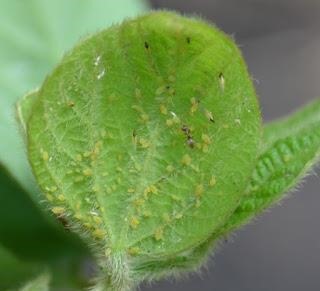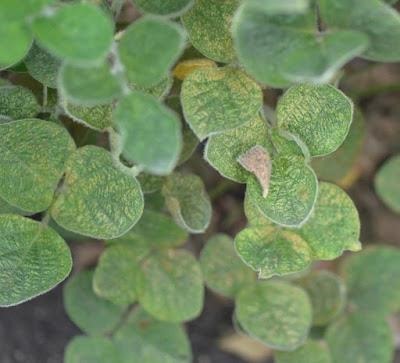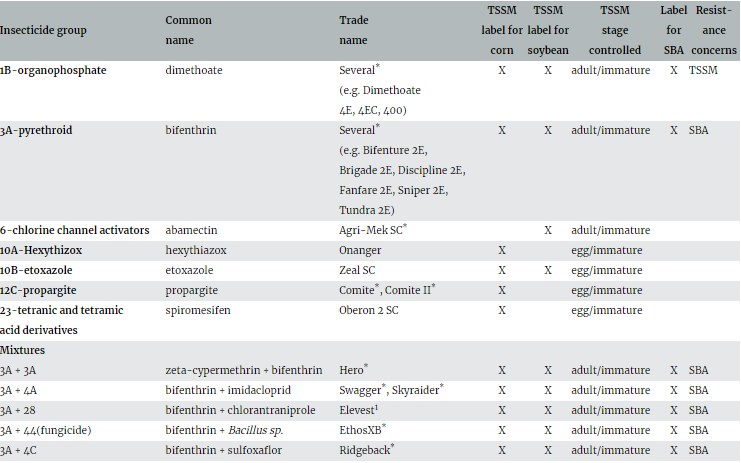By Robert Koch and Bruce Potter
Scouting of soybean for soybean aphids (SBA) and twospotted spider mites (TSSM) should be underway.
However, do not just assume you have significant infestations of either or both pests. This year, infestations of these pests are variable across the state, due to variable plant development and weather conditions. In addition, populations of both pests can rapidly change (increase or decrease). This is why scouting is particularly important. Below, we provide an overview of scouting and thresholds for these pests in soybean and a table listing the insecticides/miticides available for the management of these pests, along with notes to help determine which products to use for each pest alone or in combination.
Soybean aphids
Predators and parasites have been keeping soybean aphid populations in check in many fields; while in others, populations are approaching threshold levels. This time of year, soybean aphid populations on soybean often increase rapidly. As soybean development in fields moves toward the R5 (full pod) stage, numbers of winged soybean aphids are often triggered to leave and infest new fields, some migrating long distances (Figures 1 & 2). Drought stress or predation can also trigger aphid movement out of a field. Late-planted or maturing soybeans often see the highest soybean aphid populations late in the season.

Figure 1. A migrating aphid and her offspring. A large soybean aphid immigration often occurs in early August.

Figure 2. A soybean aphid colony in the process of leaving. In addition to winged adults. Look for wing pads and often an orange color on the nymph’s head and thorax.
Scout!
To determine when to apply insecticides for soybean aphids, count or estimate the number of aphids on plants selected throughout the field. Relate the average number of aphids per plant for that field to the economic threshold of an average of 250 aphids per plant with more than 80 percent of the plants infested with aphids, and the aphid population appears to be increasing. Please recall that the economic threshold is the trigger point for scheduling an insecticide application to prevent populations from reaching an economically damaging level, which is called the economic injury level. Scouting fields through R5 will avoid late-season surprises.
For scouting, you should pay particular attention to fields that were treated prophylactically with an insecticide mixed in with a fungicide or herbicide. Earlier insecticide applications can eliminate the natural enemies (predators and parasitic wasps) allowing populations of later-arriving aphids to increase rapidly. Also, keep in mind that as the percentage of plants infested with aphids in a field increases from about 50% to 100%, the number of aphids per plant tends to increase more rapidly.
Management of soybean aphids is complicated because many populations of soybean aphid are resistant to pyrethroid insecticides. In addition, crop tolerances for chlorpyrifos (e.g., Lorsban, Cobalt, etc.) have been revoked, so products containing this insecticide can no longer be used for this or other crop pests. However, if needed, we still have good pesticide tools to control soybean aphid.
Table 1 summarizes the insecticide options available for the management of soybean aphid and twospotted spider mite. Always read the pesticide label for timing, rates, and restrictions.
Twospotted spider mites
Some fields in drought-stressed areas of Minnesota have required miticide/insecticide applications for twospotted spider mites. Where drought conditions persist, spider mite outbreaks could occur in additional areas. Minnesota's TSSM populations are typically controlled by predators and fungal diseases. These mite-killing fungi are favored by cool, wet weather. Sometimes a few cool days and nights with heavy dews are enough to trigger a disease outbreak and rapid population collapse.

Figure 3. Severe spider mite stippling in the upper canopy of these soybeans. This injury would be a 5 on the scale described below.
Recent rains may have helped the twospotted spider mite situation in some areas. However, a single rain event with continued warm weather is unlikely to fix a mite problem without help.
Twospotted spider mite injury reduces photosynthetic area, and this lost leaf area is irreversible (the injured tissues don’t “heal”). New, compensatory leaves will no longer be produced as soybeans develop into the R5 stage.
Small light /necrotic spots (stippling) are one of the first signs of the presence of twospotted spider mites on a soybean plant. Mites and their webbing can be found on the underside of the leaves. Tapping a leaf over a white piece of paper can help you identify any live, moving adult and immature mites.
Scout for TSSM, too
To determine when to apply a miticide/insecticide for twospotted spider mites, begin scouting on the edges of fields. If the mites or the symptoms of mite infestation (stippling, yellowing, or death of leaves) are found on the edges, start sampling field interiors by inspecting multiple plants spread throughout the field. Pay close attention to field edges near permanent vegetation (grass, alfalfa, treelines, etc.). When active infestations (live mites still present) are found, use the following rating scale to determine if a miticide/insecticide is needed. Implementation of this rating scale focuses on protecting the upper two-thirds of the plant canopy, with a suggested action threshold being at level 3. Mite control after the R6.5 stage (yellow pod) stage is generally not needed.
Injury scale for twospotted spider mites in soybean
- No spider mites or injury observed.
- Minor stippling on lower leaves, no premature leaf yellowing observed.
- Stippling is common on lower leaves, small areas of scattered plants with yellowing.
- Heavy stippling on lower leaves with some stippling progressing into the middle canopy. Mites are present in the middle canopy with scattered colonies in the upper canopy. Lower leaf yellowing is common, and some lower leaf loss may be found. (Spray threshold)
- Lower leaf yellowing is readily apparent. Leaf drop is common. Stippling, webbing, and mites are common in the middle canopy. Mites and minor stippling are present in the upper canopy. (Economic loss)
- Lower leaf loss common, yellowing or browning moving up the plant into the middle canopy, stippling and distortion of upper leaves common. Mites are present in high levels in the middle and lower canopy.
Pesticide options for twospotted spider mite in soybean are limited. Treating too early increases the chances of a field needing additional applications. Rapid re-infestation from uncontrolled eggs can occur. Because populations and crop injury can increase rapidly, scouting should be repeated every four to five days in areas with threatening mite populations. The development of twospotted spider mite resistance to pesticides is always a concern. Always check control.
Considerations for combined infestations
Some fields have infestations of both pests. Here are some considerations for such situations:
- Which is your current problem: soybean aphids or twospotted spider mites? Make your choice for insecticide/miticide based on that.
- If one of these pests is at an economic/action threshold and the other species is present but below action levels, choose a product that is least likely to flare (make worse) the secondary pest infestation.
- Do not skimp on insecticide/miticide rates. Some premixes contain lower rates of one or both insecticides compared to products with just one of the insecticides. Bifenthrin has continued to be effective against spider mites in Minnesota, but lower rates in some premixes may be below that needed for consistent mite control.
- Many soybean insecticides/miticides do not control twospotted spider mite eggs. It is important to check control.
- Some insecticides may not be as easy to obtain. Plan ahead and don't waste insecticide on non-problems.
- Some premixes that control both mites and aphids combine two insecticide groups. Remember that you have already exposed mites and/or aphids in the field to two groups if you need to re-treat.
Table 1. Pesticides labeled for control of two-spotted spider mite (TSSM) on corn and both TSSM and soybean aphid (SBA) on soybean.

Source : umn.edu